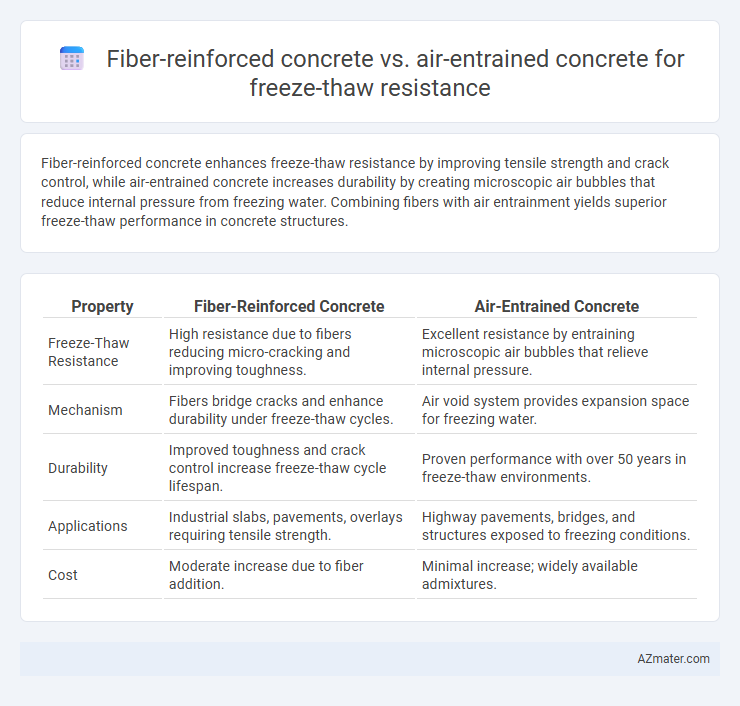Fiber-reinforced concrete enhances freeze-thaw resistance by improving tensile strength and crack control, while air-entrained concrete increases durability by creating microscopic air bubbles that reduce internal pressure from freezing water. Combining fibers with air entrainment yields superior freeze-thaw performance in concrete structures.
Table of Comparison
| Property | Fiber-Reinforced Concrete | Air-Entrained Concrete |
|---|---|---|
| Freeze-Thaw Resistance | High resistance due to fibers reducing micro-cracking and improving toughness. | Excellent resistance by entraining microscopic air bubbles that relieve internal pressure. |
| Mechanism | Fibers bridge cracks and enhance durability under freeze-thaw cycles. | Air void system provides expansion space for freezing water. |
| Durability | Improved toughness and crack control increase freeze-thaw cycle lifespan. | Proven performance with over 50 years in freeze-thaw environments. |
| Applications | Industrial slabs, pavements, overlays requiring tensile strength. | Highway pavements, bridges, and structures exposed to freezing conditions. |
| Cost | Moderate increase due to fiber addition. | Minimal increase; widely available admixtures. |
Introduction to Freeze-Thaw Resistance in Concrete
Freeze-thaw resistance in concrete refers to the material's ability to withstand cycles of freezing and thawing without significant deterioration or loss of structural integrity. Fiber-reinforced concrete improves durability by reducing microcrack propagation through embedded fibers, enhancing tensile strength and toughness during freeze-thaw cycles. Air-entrained concrete, designed with microscopic air bubbles, effectively mitigates freeze-thaw damage by providing internal space for water expansion, preventing internal stress and scaling.
Understanding Fiber-Reinforced Concrete
Fiber-reinforced concrete (FRC) enhances freeze-thaw resistance by incorporating synthetic or steel fibers that reduce microcracking and improve tensile strength, limiting water infiltration and ice expansion damage. Unlike air-entrained concrete, which relies on uniform microscopic air bubbles to accommodate ice expansion, FRC provides mechanical reinforcement that controls fracture propagation during freeze-thaw cycles. The synergistic effect of fibers improves durability and extends service life in environments subjected to cyclic freezing and thawing conditions.
What is Air-Entrained Concrete?
Air-entrained concrete contains microscopic air bubbles introduced during mixing to improve freeze-thaw resistance by allowing space for water to expand as it freezes, reducing internal pressure and cracking. Fiber-reinforced concrete, while enhancing tensile strength and crack control, does not provide the same specific freeze-thaw durability mechanisms as air-entrained concrete. Air-entrainment is the most effective method for preventing freeze-thaw damage in concrete exposed to cyclic freezing and thawing environments.
Mechanisms of Freeze-Thaw Damage
Fiber-reinforced concrete enhances freeze-thaw resistance by providing improved crack control through the bridging action of fibers, which limits microcrack formation and propagation during freeze-thaw cycles. Air-entrained concrete resists freeze-thaw damage primarily by containing uniformly distributed microscopic air bubbles that act as pressure relief sites, preventing internal stress buildup from ice expansion. The difference in mechanisms lies in fiber reinforcement improving tensile strength and toughness, while air entrainment mitigates freeze-induced hydraulic pressures within the concrete matrix.
Comparing Fiber-Reinforcement and Air-Entraining Techniques
Fiber-reinforced concrete enhances freeze-thaw resistance by distributing internal stresses and reducing crack propagation through embedded fibers, improving durability in cyclic freezing conditions. Air-entrained concrete achieves freeze-thaw protection by incorporating microscopic air bubbles that accommodate ice expansion, preventing internal damage. Comparing both methods, fiber reinforcement offers improved structural toughness, while air-entraining techniques primarily focus on freeze-thaw resilience through enhanced freeze expansion mitigation.
Performance of Fiber-Reinforced Concrete in Cold Climates
Fiber-reinforced concrete exhibits superior freeze-thaw resistance in cold climates due to its enhanced tensile strength and crack control capabilities, reducing micro-cracking and improving durability under cyclic freezing and thawing. Unlike air-entrained concrete, which relies on microscopic air bubbles to accommodate ice expansion, fiber reinforcement provides continuous structural support that mitigates surface scaling and internal damage. Studies confirm that fiber-reinforced concrete maintains higher residual strength and less degradation in harsh freeze-thaw environments, making it a reliable choice for infrastructure exposed to severe winters.
Freeze-Thaw Durability of Air-Entrained Concrete
Air-entrained concrete exhibits superior freeze-thaw durability due to its intentionally created microscopic air bubbles, which provide space for water to expand upon freezing, thereby reducing internal stress and cracking. Fiber-reinforced concrete improves tensile strength and crack control but does not inherently address freeze-thaw cycles as effectively as air-entrainment. For environments subject to cyclic freezing and thawing, air-entrained concrete remains the preferred choice due to its proven resistance to surface scaling and internal damage.
Synergistic Effects: Using Fibers and Air-Entraining Agents Together
Combining fiber-reinforced concrete with air-entraining agents significantly enhances freeze-thaw resistance by improving microstructural integrity and providing controlled air voids that accommodate ice expansion. Fibers increase tensile strength and reduce crack propagation, while air-entrained voids mitigate internal stresses caused by freezing water. This synergy results in durable concrete capable of withstanding repeated freeze-thaw cycles in harsh environments.
Practical Applications and Cost Considerations
Fiber-reinforced concrete enhances freeze-thaw resistance by improving toughness and controlling crack propagation, making it ideal for pavements, bridge decks, and industrial floors exposed to harsh climates. Air-entrained concrete offers superior freeze-thaw durability by incorporating microscopic air bubbles that relieve internal pressure, commonly used in residential foundations, sidewalks, and highway surfaces in cold regions. While fiber-reinforced concrete generally incurs higher initial costs due to fiber materials and mixing, its long-term maintenance savings can offset expenses, whereas air-entrained concrete remains cost-effective for large-scale applications with consistent freeze-thaw demands.
Conclusion: Selecting the Best Concrete for Freeze-Thaw Resistance
Fiber-reinforced concrete enhances freeze-thaw resistance by improving tensile strength and reducing crack propagation, making it ideal for structures subject to dynamic stress. Air-entrained concrete excels by incorporating microscopic air bubbles that relieve internal pressure from ice formation, significantly reducing surface scaling and internal damage. For optimal freeze-thaw durability, selecting between fiber-reinforced or air-entrained concrete depends on specific exposure conditions, budget constraints, and structural performance requirements.

Infographic: Fiber-reinforced concrete vs Air-entrained concrete for Freeze-thaw resistance
 azmater.com
azmater.com